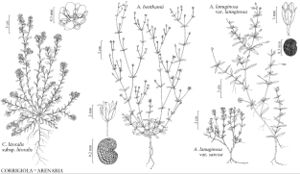Arenaria
Sp. Pl. 1: 423. 1753.
Gen. Pl. ed. 5, 193. 1754.
| Taxon | Illustrator ⠉ | |
|---|---|---|
 | Arenaria benthamii Arenaria lanuginosa var. lanuginosa Arenaria lanuginosa var. saxosa Corrigiola litoralis subsp. litoralis | Yevonn Wilson-Ramsey |
Plants annual or perennial, sometimes densely matted. Taproots filiform to moderately thickened; rhizomes slender. Stems prostrate to ascending or erect, simple or branched, terete to ellipsoid, angular or grooved. Leaves mostly connate, mostly sessile, not congested at or near base of flowering-stem; blade 1-veined or 3–5-veined, rarely linear or linear-lanceolate to usually elliptic to ovate or rarely orbiculate, sometimes subsucculent or succulent, apex blunt or obtuse to acute, acuminate, or apiculate. Inflorescences terminal or axillary open cymes, or flowers solitary; bracts paired, smaller, foliaceous. Pedicels erect or ascending to reflexed in fruit. Flowers: perianth and androecium hypogynous; sepals 5, distinct or barely connate proximally, green or rarely distally purple, lanceolate to broadly ovate, 2–5 mm, margins foliaceous or white and scarious, apex obtuse to rounded or acute to acuminate, not hooded; petals 5 or absent, white, not clawed, blade apex entire; nectaries at base of filaments opposite sepals; stamens 10 (ca. 8 in A. livermorensis), arising from base of ovary; filaments distinct; staminodes absent; styles 3, filiform, 0.5–2 mm, glabrous proximally; stigmas 3, linear along adaxial surfaces of styles, papillate (30×). Capsules broadly ellipsoid or ovoid to cylindric, opening by 6 ascending to recurved teeth; carpophore absent. Seeds [1–] 5–35, brown to dark-brown or black, reniform or suborbicular, laterally compressed or not, shiny or dull, smooth, rugulose, or tuberculate, marginal wing absent, appendage absent. x = [7, 8?] 10, 11.
Distribution
North-temperate regions, w North America (including Mexico), Central America, South America (Andes), Eurasian mountains, Mediterranean region, Asia Minor
Discussion
Species 210 (9 in the flora).
Our treatment of Arenaria follows J. McNeill (1962, 1980b) in segregating Minuartia from Arenaria, while we take an additional step in recognizing Eremogone. While a broad concept of Arenaria is often used in North American works (e.g., B. E. Wofford 1981), splitting Arenaria is supported by morphological and molecular evidence (M. Nepokroeff et al. 2001).
J. McNeill (1962) outlined an infrageneric classification of Arenaria consisting of ten subgenera. The nine species of Arenaria occurring in North America belong to two subgenera (Leiosperma McNeill and Arenaria) and two sections within subg. Arenaria (Rariflorae F. Williams and Arenaria). Based in part on recent molecular evidence (M. Nepokroeff et al. 2001), we are here treating two of McNeill’s subgenera as belonging to the genus Eremogone.
Selected References
None.
Lower Taxa
Key
| 1 | Plants annual, not mat-forming; stems erect to ascending | > 2 |
| 1 | Plants perennial, often mat-forming, usually rhizomatous; stems prostrate, seldom erect or ascending | > 4 |
| 2 | Stems uniformly puberulent; leaf blades 3-5-veined; sepals 3-veined, stipitate-glandular | Arenaria serpyllifolia |
| 2 | Stems puberulent in 2 lines; leaf blades 1-veined; sepals 1-veined, glabrous | > 3 |
| 3 | Sepals strongly keeled proximally; seeds dark brown to black, shiny, suborbicular, obscurely tuberculate | Arenaria ludens |
| 3 | Sepals not keeled; seeds ashy brown, dull, broadly reniform, minutely/prominently rounded-tuberculate | Arenaria benthamii |
| 4 | Plants cespitose or pulvinate; stems usually shorter than 10 cm; seeds brown to black, rugulose or tuberculate; boreal | > 5 |
| 4 | Plants with stems mostly longer than 10 cm (if matted, then to 4 cm); seeds dark brown or black, shiny, smooth; s, sw United States | > 7 |
| 5 | Rhizomes absent; sepals narrowly lanceolate; petals obovate, 12/ 3-2 times as long as sepals; seeds black to reddish brown, low-tuberculate | Arenaria pseudofrigida |
| 5 | Rhizomes present, sepals ovate; petals broadly elliptic or oblanceolate, ± 1-11/ 2 times as long as sepals; seeds brown, rugulose or faintly so | > 6 |
| 6 | Leaf blade margins ciliate proximally; pedicels 10-20 mm; capsules ellipsoid | Arenaria longipedunculata |
| 6 | Leaf blade margins smooth; pedicels 1-10 mm; capsules broadly ellipsoid | Arenaria humifusa |
| 7 | Plants matted, mosslike; leaf blade margins with peglike cilia | Arenaria livermorensis |
| 7 | Plants not matted; leaf blade margins glabrous or with hairlike cilia | > 8 |
| 8 | Stem internodes and pedicels glabrous; sepals obscurely 1-veined, apices obtuse to rounded; petals 1 2-2 times as long as sepals | Arenaria paludicola |
| 8 | Stem internodes and pedicels retrorsely-pubescent; sepals 1-3-veined, apices acute to acuminate; petals 2-1 5 times as long as sepals | Arenaria lanuginosa |